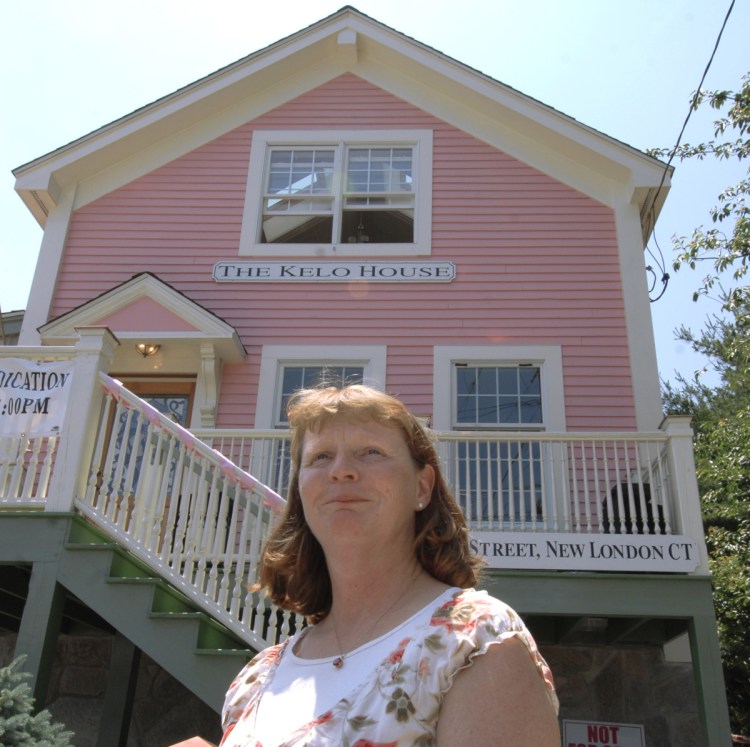WASHINGTON — Susette Kelo’s Supreme Court case now has a Hollywood ending, just not the one she hoped for.
What Kelo wanted when she took her case to the high court more than a decade ago was to get to stay in her little pink house in New London, Connecticut. The city was trying to force her out to make way for development, and Kelo didn’t want to go. The high court ruled against her.
Now, however, Kelo’s story has been turned into a movie, “Little Pink House,” opening Friday in limited nationwide release. It’s a movie she and those involved in the film hope will get people to think about the government’s power to take private property for public use. Governments can use that power, called eminent domain, as long as they fairly compensate owners.
Kelo, who was in Washington this week to speak about the film, said what city and state officials did “ripped our hearts out.”
Kelo wasn’t looking for a fight when she bought her house overlooking the Thames River in 1997 and had it painted Odessa Rose pink. Divorced and with five grown sons, she was looking for a place of her own. She found it in the 100-year-old cottage. Shortly after she moved in, pharmaceutical manufacturer Pfizer announced it would move in nearby, building a research facility that opened in 2001.
New London hoped Pfizer’s move could help revitalize the city and, with the help of a private nonprofit development corporation, sought to redevelop land near the facility. A hotel, housing, office space, restaurants and shopping were planned. To get it done, the city authorized the use of eminent domain.
Kelo thought that was wrong, and she and a small group of other homeowners took on the city. They acknowledged eminent domain could be used to take their homes for public uses such as a road or military base, but they argued the planned development didn’t count.
“She was just fearless,” said Oscar-nominated actress Catherine Keener, who plays Kelo in the movie. “She took on everybody.”
Kelo had help. The Virginia-based Institute for Justice represented her and the other homeowners. The group was also instrumental in the new movie’s making, bringing a book about the case to the attention of filmmakers Courtney Moorehead Balaker and Ted Balaker.
Courtney Balaker, the movie’s writer and director, said she was “blown away” by Kelo’s case but also by Kelo herself. She compared her story to that of Erin Brockovich, a nonlawyer and divorced mother of three who took on utility company PG&E over contaminated groundwater in Hinkley, California, inspiring a 2000 movie. One big difference: Brockovich won.
In 2005, the Supreme Court ruled against Kelo 5-4. Three justices who sided with the city – Ruth Bader Ginsburg, Stephen Breyer and Anthony Kennedy – are still on the court. The two others – John Paul Stevens and David Souter – have since retired. The justices wrote that the city had carefully crafted a development plan it believed would benefit the community. They agreed the use of eminent domain was permitted.
“I want people to walk away thinking about if that’s right,” Balaker said.
Stevens, the Supreme Court justice who authored the opinion, has acknowledged it was the most unpopular one he wrote. Justice Antonin Scalia, who dissented from the decision, ranked it among the court’s biggest mistakes.
After the decision, more than 20 states significantly revised their laws to make it more difficult to take property through eminent domain, said Dana Berliner, litigation director for the Institute for Justice.
Those changes didn’t help Kelo, who had to move. And despite the lengthy legal battle, her land still stands empty. Pfizer announced in 2009 that it would leave New London. But General Dynamics Electric Boat now occupies its former facility with many more employees, said New London Mayor Michael Passero.
Passero, a Democrat who grew up in the city, said while the movie vilifies the development corporation, he believes the people behind it had good motives, though they also made mistakes. More than anything, he said, the story is a cautionary tale about two sides becoming so polarized they couldn’t find a middle ground.
Kelo’s little pink house was ultimately saved. Disassembled and moved but still painted pink, it stands on New London’s Franklin Street. Although Kelo doesn’t live there, she says she thinks about her former home and her legal fight often.
“A lot of people ask: ‘How are you all doin’? … How are your neighbors? How did you survive this?”‘ she said of recent appearances in connection with the movie. She answers that they’ve left the city, bought new homes and are trying to do “the best we can to recover.”
Send questions/comments to the editors.


